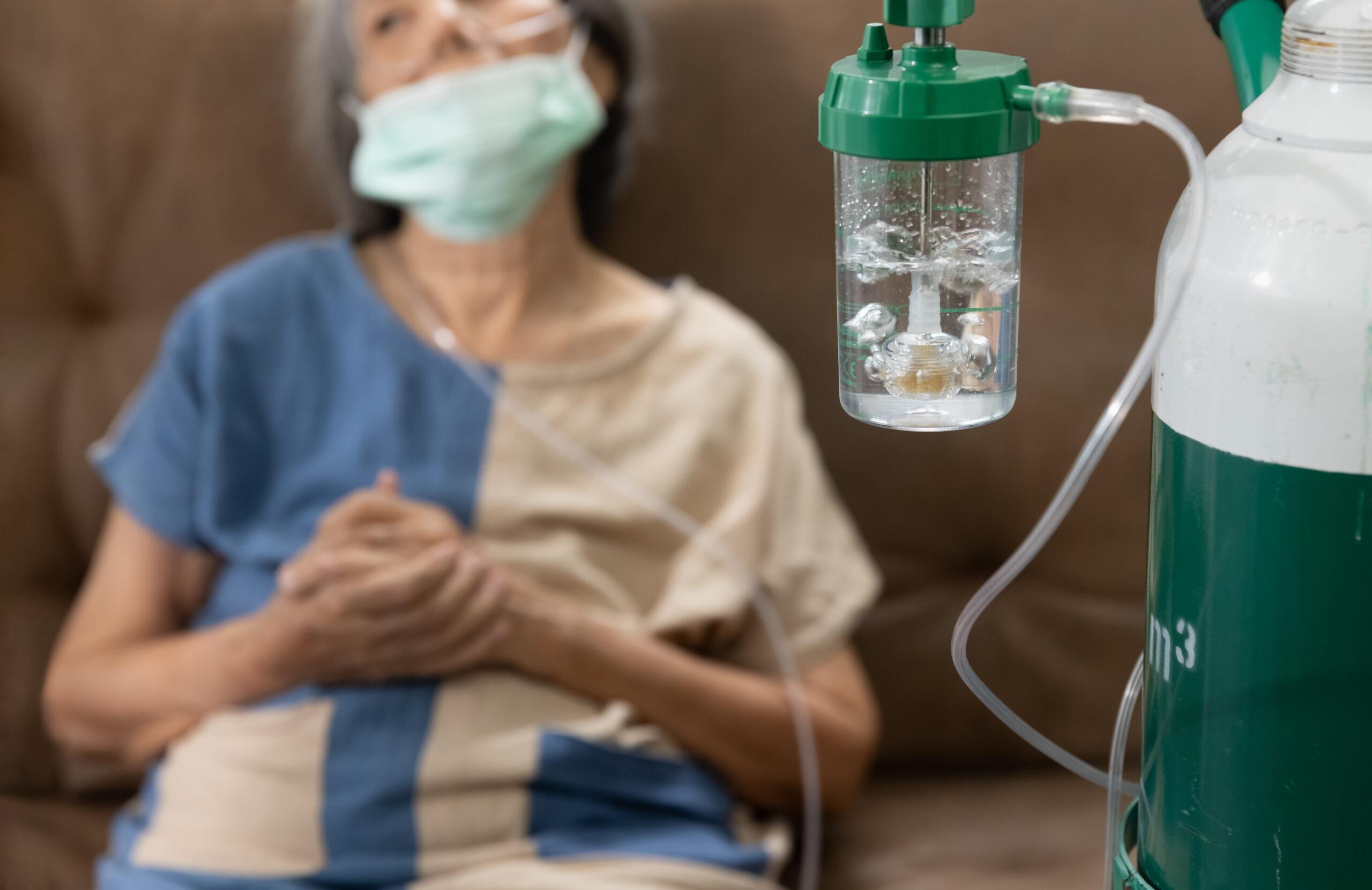8 Guidelines For Using Oxygen in Hospice
Oxygen therapy plays a crucial role in hospice care by enabling patients who struggle with respiration to experience a greater level of comfort. This piece offers an all-inclusive resource for hospice caregivers, nurses, and agency supervisors regarding the use and application of oxygen therapy and its associated equipment. With the correct training, caregivers can confidently and safely operate the equipment.

Guidelines for Safe Oxygen Use in Hospice Care
To optimize the benefits of oxygen therapy and ensure patient safety, caregivers must follow these guidelines:
- Use non-petroleum-based lip balms or lotions for dry and chaffed lips or noses. Beeswax or other natural oil-based products are recommended. It is important to use water-based lip balms, such as Burt’s Bees, when using oxygen, to prevent fire hazards.
- Seek advice from the hospice care team for padding or wearing tubing to avoid irritation and soreness.
- Always consult the doctor or hospice care team before adjusting the liter flow. Increasing the oxygen flow rate may not always help and can sometimes worsen the patient’s condition.
- Avoid placing oxygen tubing under furniture, rugs, or other items to prevent kinking. Be mindful of tubing placement to prevent tripping and falls.
- Maintain a smoke-free environment and keep oxygen equipment at least 10 feet away from open flames.
- Refrain from using electrical equipment that could spark when using oxygen.
Hospice Oxygen Policy: When to Stop Giving Oxygen at End of Life
The decision to discontinue oxygen therapy in hospice care involves several key considerations:
- Patient Comfort: If oxygen no longer contributes to patient comfort or quality of life.
- Medical Assessment: Based on the healthcare team’s evaluation of the Patient’s condition.
- Family and Patient Wishes: Respecting the Patient’s and their family’s desires regarding end-of-life care.
- Symptom Management: Stopping oxygen if it’s no longer effective in symptom management, like alleviating breathlessness.
- Oxygen Levels Monitoring: Regularly monitoring oxygen levels to determine whether continued therapy is beneficial.
- Ethical Considerations: Ensuring decisions align with ethical guidelines in palliative care.

CONTINUA LEARNING
Simplify Your Hospice Team’s Training and Skill Building
A complete solution for your agency: more than 125 hospice courses, caregiver in-services, training plans, and more.
Understanding Oxygen Prescription and Delivery in Hospice
Doctors prescribe supplemental oxygen in terms of liters per minute, e.g., 2 L/min. The specified amount may vary depending on the patient’s condition and needs. Oxygen can be provided through two primary methods: oxygen concentrators and oxygen tanks.

Understanding Oxygen Levels in Hospice Care
Monitoring and managing oxygen levels in hospice care is crucial for patient comfort and symptom management. This involves:
- Regular Monitoring: Frequent checks of the Patient’s oxygen saturation levels using a pulse oximeter.
- Adjusting Oxygen Flow: Modifying the oxygen flow rate based on the Patient’s needs and doctor’s prescription.
- Symptom Observation: Noting symptoms like breathlessness or confusion, which might indicate changes in oxygen requirements.
- Patient Comfort Focus: Prioritizing patient comfort in increasing or decreasing oxygen support.
- Family Education: Teaching family members about the significance of oxygen levels and what changes might mean for the Patient’s care.
- Professional Consultation: The hospice team regularly consults with healthcare providers to ensure optimal oxygen level management.
Oxygen Concentrators in Hospice Care
An oxygen concentrator is an electricity-powered machine that extracts oxygen from the air and concentrates it for patient use. This device never runs out of oxygen, making it an ideal option for in-home care.
Tips for using an oxygen concentrator:
- Ensure adequate air circulation by placing the concentrator 12-24 inches away from walls, furniture, curtains, etc.
- Clean the filter weekly.
- When turned on, the machine will emit a short alarm, indicating proper oxygen flow.
- Check and adjust the flow rate according to the doctor’s prescription.
- Replace the nasal cannula every two weeks.
- Inspect the tubing for kinks or disconnections if the oxygen flow seems incorrect.
- Turn off the concentrator when not in use.
Oxygen Tanks in Hospice Care
Oxygen tanks are portable metal cylinders that store a specific amount of oxygen. They are ideal for use without electricity or when away from home. Oxygen tanks need to be replaced periodically when depleted.
Tips for using portable oxygen tanks:
- Open the tank using the E-wrench provided during delivery. Turn the valve counterclockwise to check the oxygen level.
- Order a new oxygen tank when the current tank is one-quarter full.
- Set the flow rate according to the doctor’s prescription.
- Keep oxygen tanks in an upright position during travel.
- Turn off the tank when not in use by setting the flow rate to zero and turning the knob clockwise.

Maintaining Oxygen Equipment in Hospice Care
Regular maintenance of oxygen equipment ensures its proper functioning and prolongs its lifespan. Here are some tips for maintaining your oxygen equipment:
- Inspect the tubing, cannulas, and connections regularly for wear and tear. Replace them as needed.
- Clean the nasal cannula with a mild soap solution and rinse thoroughly. Allow it to air dry before reusing.
- Check for leaks in the tubing and connections. If a leak is detected, replace the damaged part immediately.
- Keep the oxygen equipment clean and dust-free. Wipe down the surfaces with a damp cloth and mild soap when necessary.
Preparing for Emergencies and Power Outages
Power outages and other emergencies can pose challenges for patients using oxygen therapy. In emergencies, understanding when and how to safely remove oxygen from a dying patient is crucial. Hospice caregivers must be prepared to handle such situations effectively:
- Always have a readily available backup oxygen source, such as a portable oxygen tank.
- Develop an emergency plan with your hospice care team, including instructions for backup oxygen sources and contact information for emergency services.
- Keep a list of important phone numbers, such as the hospice agency, oxygen supplier, and local emergency services, easily accessible.
- Ensure that the patient, caregivers, and family members are familiar with the emergency plan and know how to use the backup oxygen source.
Educating Family Members and Friends on Oxygen Safety in Hospice
It is essential to inform family members and friends about the safe use of oxygen therapy equipment to maintain a secure environment for the hospice patient:
- Educate them on the importance of not smoking in the patient’s vicinity and maintaining a safe distance from open flames.
- Make them aware of the placement of oxygen tubing to prevent tripping and falls.
- Teach them about the proper use of oxygen equipment and the steps to take during emergencies.

The Role of Hospice Training in Oxygen Therapy
Proper hospice training is crucial for caregivers and hospice agency staff to ensure they can provide the best care to patients receiving oxygen therapy. Comprehensive training should include the following:
- Understanding the different types of oxygen delivery systems and their applications.
- Learning how to operate and maintain oxygen equipment safely and efficiently.
- Gaining knowledge of emergency procedures and backup plans for oxygen therapy.
- Acquiring communication skills to educate patients, family members, and friends on the safe use of oxygen therapy equipment.
Hospice training equips caregivers with the skills and knowledge required for safe and effective oxygen therapy. By adhering to guidelines, maintaining equipment, preparing for emergencies, and educating those around them, caregivers can provide the highest level of care to patients with breathing difficulties. Look for an online hospice training solution to build your team’s skills.
Contact Your Hospice Care Team for Support
It is crucial to contact your hospice care team if you have any questions or concerns about using oxygen. Proper training and adherence to guidelines will help caregivers provide the best possible care for patients needing oxygen therapy.
FAQs
Should you remove oxygen at end of life?
Removing oxygen at the end of life is a complex and individual decision. It’s essential to consider the patient and their family’s wishes, comfort, and prognosis. Withholding or withdrawing oxygen may be appropriate in certain situations, such as when it provides no benefit or causes discomfort.
When should I stop oxygen administration in hospice care?
Oxygen administration in hospice care should be stopped when it no longer provides comfort or improves the patient’s quality of life. In collaboration with the patient, family members, and other clinicians, the hospice care team can decide by considering the patient’s goals, symptoms, and overall condition. Always consult the hospice care team to determine when to stop oxygen administration.
Why do they give oxygen to dying patients?
Oxygen is given to dying patients to alleviate symptoms of breathlessness and maintain comfort. It is also provided in the event of hypoxemic respiratory failure. This process, called palliative oxygen therapy, aims to improve patient’s quality of life during their final moments. It may help reduce anxiety and feelings of air hunger, ensuring the patient remains as comfortable as possible in their last stages.
Can you use a fireplace with oxygen in the house?
Yes, you can use a fireplace in a house with oxygen present, as fireplaces rely on oxygen for combustion. However, if you’re using supplemental oxygen therapy, it’s crucial to exercise caution. Keep oxygen sources at least 5-10 feet from open flames, and avoid smoking near the equipment. Always follow safety guidelines and maintain proper ventilation to reduce the risk of fire or carbon monoxide poisoning.
Does oxygen extend life in hospice?
Oxygen therapy in hospice care helps alleviate symptoms such as shortness of breath. While it may improve quality of life, oxygen does not extend overall life expectancy in hospice patients. The primary goal of hospice care is to provide comfort and symptom management rather than prolonging life.
Why do oxygen levels drop at the end of life?
A weakening respiratory system causes oxygen levels to drop at the end of life. As organs and tissues lose function, the body struggles to take in and transport oxygen effectively. This results in decreased oxygen saturation, ultimately contributing to the body’s systems shutting down and causing the eventual end of life.
What lip balms can be used with oxygen?
Go for lip balms that are water-based or contain no petroleum, as petroleum-based products can be flammable. Lips balms with natural ingredients like beeswax, shea butter, cocoa butter, aloe vera, or glycerin are all great choices. Brands like Aquaphor, Burt’s Bees, and Eucerin offer suitable options.
What can you use for dry lips while on oxygen?
You can use lip balms, ointments, or petroleum jelly to alleviate dry lips while on oxygen therapy. Choose products that are unscented, hypoallergenic, and free of irritants. Drinking plenty of water and using a humidifier in your room can also help maintain lip moisture. Avoid licking your lips, as this can worsen dryness.
Why put a dying person on oxygen?
Oxygen is used in hospice care to alleviate symptoms like breathlessness and to maintain comfort, especially in the event of hypoxemic respiratory failure. It helps improve the quality of life during their final moments.
Does hospice provide oxygen?
Yes, hospice care often includes oxygen therapy as part of the comprehensive care plan to manage symptoms and improve patient comfort. This ensures that patients receive the necessary support for their respiratory needs.
